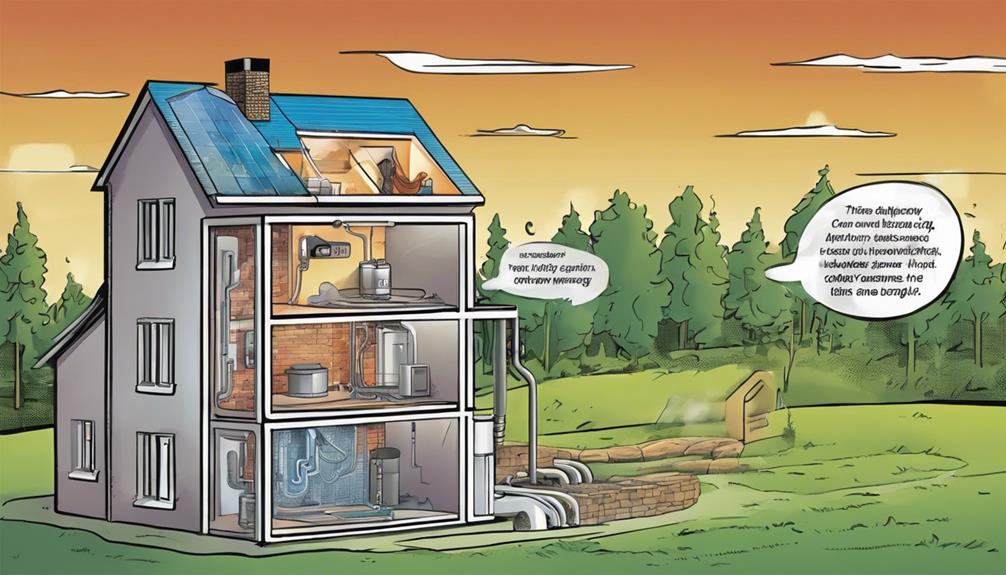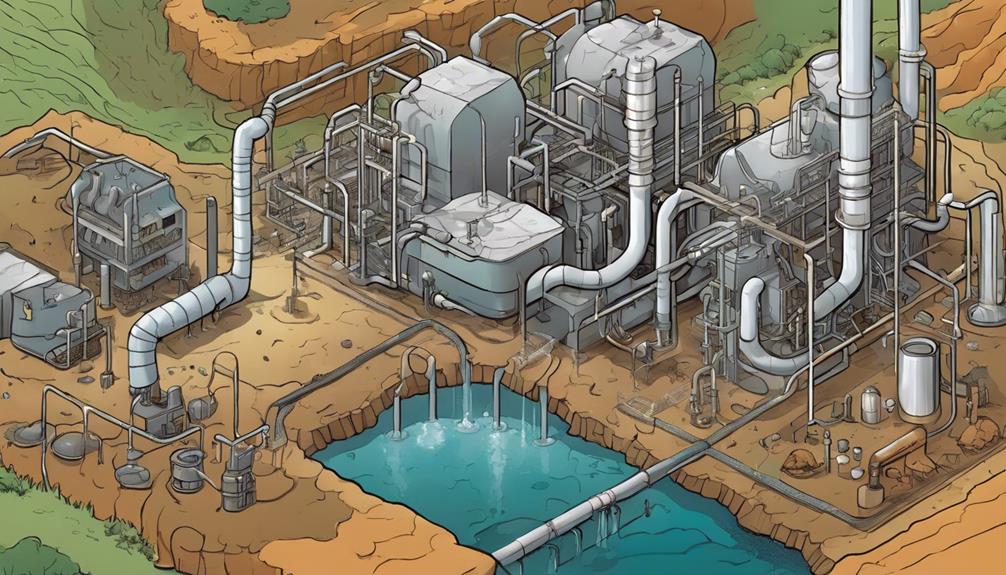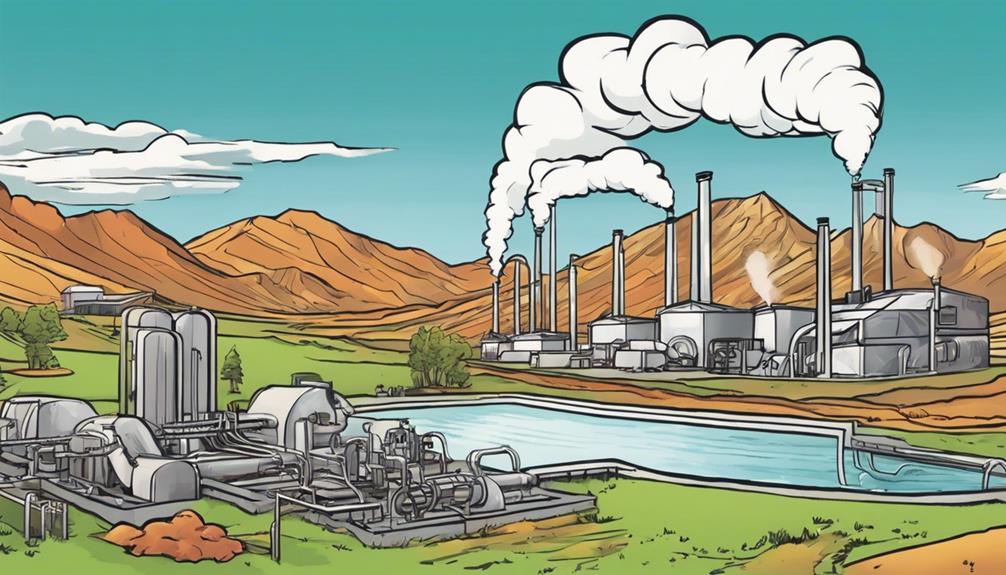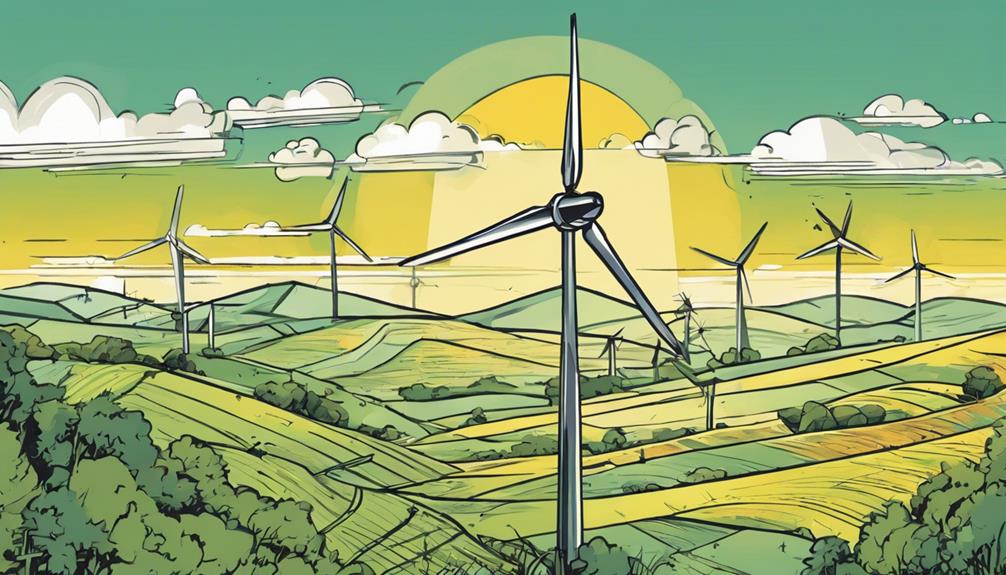Geothermal energy serves as a sustainable solution for heating, cooling, and generating electricity. It reduces dependence on fossil fuels, assists in greenhouse gas emission reduction, and provides reliable energy. District heating systems offer warmth to communities while industrial uses encompass food processing and manufacturing. Geothermal heat pumps guarantee cost-effective heating and cooling. Electricity generation through geothermal plants adds stability to the power grid. Additionally, specialized applications like aquaculture heating and greenhouse operations benefit from its efficiency. Discover the wide array of uses geothermal energy offers for various sectors beyond traditional heating and cooling.
Key Takeaways
- Geothermal district heating systems for warmth and reduced reliance on fossil fuels.
- Geothermal heat pumps for cost-effective heating and cooling, enhancing energy efficiency.
- Geothermal power plants for consistent electricity generation and reduced greenhouse gas emissions.
- Industrial uses in food processing, desalination, and manufacturing sectors.
- Specialized applications in aquaculture heating, greenhouse operations, spas, pools, and cooling systems.
Direct Applications
Direct applications of geothermal energy involve utilizing heated water for various purposes without the need for specialized equipment. Geothermal district heating systems are a prime example of direct-use applications, where hot water from underground reservoirs is circulated through buildings to provide warmth. This method isn't only efficient but also environmentally friendly, as it reduces the reliance on fossil fuels for heating.
Hot water from geothermal sources is also utilized in heating and cooling systems, offering a sustainable alternative to traditional HVAC systems. By tapping into geothermal resources typically ranging from 50-150°C, buildings can be heated in the winter and cooled in the summer with minimal impact on the environment.
Additionally, historical civilizations like the Native Americans, Greeks, and Romans have long utilized geothermal energy for activities such as cooking and bathing, showcasing the longstanding practicality and versatility of direct geothermal applications.
Heat Pumps

Utilizing the Earth's shallow ground temperature, heat pumps efficiently provide both heating and cooling for buildings, offering a sustainable and cost-effective solution. Geothermal heat pumps leverage the constant temperature of the Earth's surface to reduce energy consumption significantly compared to traditional heating and cooling systems. By transferring heat between a building and the ground, these systems enhance energy efficiency while lowering operational costs.
Geothermal heat pumps play a pivotal role in sustainable building design by offering a renewable energy technology that helps decrease greenhouse gas emissions and reduce reliance on fossil fuels. The utilization of geothermal heat pumps represents a growing trend in the construction industry, promoting energy-efficient HVAC systems and environmentally friendly practices.
Electricity Generation

Geothermal energy for electricity generation involves tapping into hot water or steam reservoirs deep within the earth through drilling. This process allows for the generation of electricity using the natural heat found underground.
Here are three key points about geothermal electricity generation:
- Reliable Source: Geothermal power plants convert the heat from the earth into electricity, providing a consistent and reliable source of energy that can contribute to the stability of the power grid.
- Environmental Benefits: By utilizing hot water and steam to generate electricity, geothermal power plants help reduce the reliance on fossil fuels, making them a cleaner energy option with lower greenhouse gas emissions.
- Technological Advancements: Enhanced geothermal systems (EGS) technologies show promise in making geothermal energy more widely accessible for electricity generation across various regions, potentially expanding the reach and impact of this renewable energy source.
District Heating

Geothermal district heating offers efficient heating systems that benefit both the environment and your community. By utilizing this sustainable energy source, you can contribute to reducing greenhouse gas emissions and lowering energy costs for your neighborhood.
Embracing geothermal district heating can provide reliable warmth to multiple buildings from a centralized and eco-friendly source.
Efficient Heating Systems
Efficient district heating systems harness the natural heat from underground reservoirs to provide sustainable and reliable warmth to buildings.
When it comes to geothermal heating for district systems, here's what you need to know:
- Cost-Effective: Geothermal district heating systems aren't only environmentally friendly but also offer cost savings compared to traditional heating methods.
- Consistent Heating: By utilizing geothermal resources, district heating systems can provide a stable and consistent source of heat to residential and commercial areas.
- Reduction in Emissions: These systems reduce the reliance on fossil fuels, consequently decreasing greenhouse gas emissions and promoting the use of renewable energy sources.
These advantages make geothermal energy a compelling choice for efficient heating systems in communities looking to prioritize sustainability and energy efficiency.
Sustainable Community Warmth
For sustainable community warmth through district heating systems, the utilization of geothermal energy plays a pivotal role in reducing carbon emissions and fostering energy efficiency. Geothermal energy is harnessed to produce heat, which is then used to warm water or generate steam. This hot water or steam is circulated through pipes to provide heating for multiple buildings within a community. By sharing geothermal heat among residential, commercial, and industrial structures, district heating networks help reduce individual heating costs and lower carbon emissions markedly.
| Geothermal Energy Usage | Description | Benefits |
|---|---|---|
| Heat generation | Geothermal energy produces heat for | Reduces carbon emissions |
| Water circulation | Circulates hot water or steam | Lowers heating costs for buildings |
| Power generation | Generates power for district heating | Enhances energy efficiency |
Geothermal district heating systems not only offer reliable warmth, especially in colder regions but also contribute to environmental sustainability and promote community resilience by reducing reliance on fossil fuels. Successful implementations in countries like Iceland, Sweden, and Denmark demonstrate the effectiveness of geothermal energy in providing sustainable community warmth.
Industrial Uses

Industries across various sectors leverage geothermal energy for a wide range of industrial applications and processes. Geothermal energy is utilized in industrial applications like food dehydration, timber drying, and milk pasteurization.
Moreover, industrial processes such as desalination, greenhouse heating, and fish farming rely on geothermal energy for their operations.
Additionally, geothermal power is harnessed to power industrial operations like ethanol production, chemical manufacturing, and paper processing.
Aquaculture Heating

Geothermal energy offers efficient water heating for aquaculture, ensuring a stable and ideal environment for aquatic life. By utilizing geothermal heating, you can maintain consistent water temperatures that support the healthy growth and reproduction of fish and plants.
This sustainable method not only reduces operational costs but also fosters a more environmentally friendly approach to aquaculture heating.
Efficient Water Heating
When heating water efficiently for aquaculture purposes, geothermal energy provides a stable and most suitable environment for aquatic life. Geothermal energy is harnessed to regulate water temperatures in aquaculture facilities, ensuring the well-being of fish and promoting growth.
Here are three key benefits of using geothermal energy for aquaculture heating:
- Stability: Geothermal systems offer consistent heat, maintaining ideal water temperatures that reduce stress on aquatic organisms and contribute to their health and development.
- Cost-effectiveness: Utilizing geothermal heat pumps for aquaculture heating is a financially efficient solution, helping aquaculture operations save on energy costs in the long run.
- Environmental friendliness: By leveraging geothermal energy for water heating, aquaculture facilities can reduce their carbon footprint and operate in an eco-friendly manner, supporting sustainable practices in the industry.
Sustainable Aquatic Environment
Creating a sustainable aquatic environment through the use of geothermal energy for aquaculture heating is essential for maintaining ideal conditions for fish and aquatic organisms. Fish farms rely on geothermal heat to regulate water temperature, fostering peak growth and reproduction.
By utilizing geothermal energy for aquaculture heating, fish farms reduce their reliance on fossil fuels, resulting in lower operational costs and a decreased ecological impact. Geothermal systems in aquaculture offer consistent and cost-effective heating solutions, enabling year-round production.
The controlled environment created by geothermal energy enhances fish health and overall production efficiency in aquaculture settings. Embracing geothermal energy for aquaculture heating not only supports sustainable practices but also ensures a stable and conducive environment for aquatic life in fish farms.
Greenhouse Applications

In the field of greenhouse operations, harnessing geothermal energy proves to be a game-changer for maintaining ideal temperatures essential for plant growth.
Here are three key benefits of using geothermal energy in greenhouse applications:
- Geothermal energy is utilized in greenhouses to provide consistent heating, ensuring that plants thrive in best conditions for growth.
- Geothermal heat pumps play an important role in maintaining ideal temperatures within greenhouses, regardless of the external weather conditions, creating a stable environment for plant cultivation.
- By leveraging geothermal energy, greenhouse operators can save on heating costs and reduce their carbon footprint, offering a sustainable and eco-friendly solution for year-round crop production.
Spas and Pools

Geothermal energy offers a sustainable and cost-effective solution for heating spas and pools, maintaining warm water temperatures efficiently. By utilizing geothermal heat pumps that tap into the Earth's constant temperature, spas and pools can be heated using water or steam from beneath the surface. This method not only reduces operational costs but also minimizes carbon emissions and energy consumption associated with traditional heating methods. Geothermal heating systems provide a reliable and consistent source of warmth for spas and pools, enhancing the overall experience for users.
| Benefits of Geothermal Energy for Spas and Pools | ||||
|---|---|---|---|---|
| Sustainable and Cost-effective Heating Solution | Efficiently Maintains Warm Water Temperatures | Reduces Operational Costs | Minimizes Carbon Emissions | Consistent Source of Warmth |
Cooling Systems

Utilize geothermal energy for cooling systems by harnessing its ability to transfer heat efficiently from buildings to the ground. Geothermal cooling systems offer sustainable cooling solutions that are both cost-effective and environmentally friendly.
Here are some key points to take into account:
- Geothermal heat pumps utilize the stable temperature of the earth to provide efficient cooling for buildings.
- Energy consumption can be reduced significantly, up to 30-70%, when compared to traditional air conditioning methods, making geothermal cooling systems a more sustainable choice.
- Geothermal cooling isn't only energy-efficient but also emits fewer greenhouse gases, contributing to a healthier environment.
Frequently Asked Questions
Where Is Geothermal Energy Most Used?
Geothermal energy is most used where natural heat sources are abundant, like in power plants for electricity and in heat pumps for buildings. It's also common in industrial processes and district heating systems.
What Are the Top 5 Activities That Make Use of Geothermal Energy?
Incorporating geothermal energy into various activities is like infusing warmth into a chilly day. You can heat buildings, power district systems, assist in agriculture, manage residential cooling, and support industrial processes efficiently.
What Are 5 Facts About Geothermal Energy?
When you think about geothermal energy, remember its Greek origins meaning earth heat. This renewable energy source is harnessed through technologies like drilling for hot water or steam deep underground, mainly in areas like the western U.S.
Is Geothermal Energy Used for Heating?
Yes, geothermal energy is indeed used for heating. It offers a reliable and sustainable alternative to traditional heating methods by utilizing hot water from underground reservoirs or extracting heat from the Earth's shallow ground through heat pumps.
How Does California Harness Geothermal Energy for its Main Uses?
California’s geothermal energy source plays a vital role in providing sustainable power for the state. Through the use of geothermal power plants, California harnesses this natural resource to generate electricity, heat buildings, and even grow greenhouse crops. This renewable energy source is a valuable asset for California’s energy needs.
Conclusion
Just like a well-oiled machine, geothermal energy has a variety of uses that work together seamlessly to provide sustainable power.
From heating homes and buildings to generating electricity and even keeping fish warm in aquaculture, geothermal energy is a versatile and reliable source of power.
So, next time you turn up the heat or take a dip in a warm pool, remember the hidden power beneath the surface that keeps everything running smoothly.










